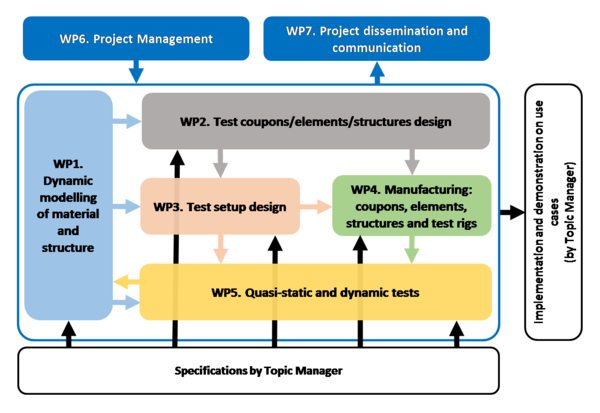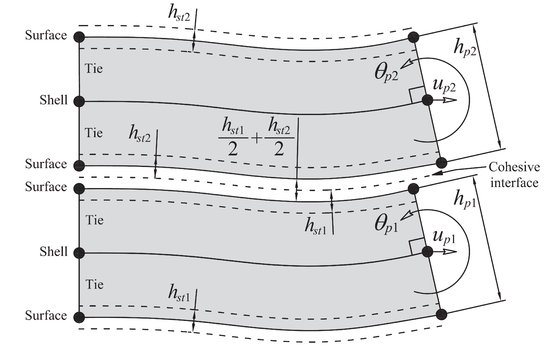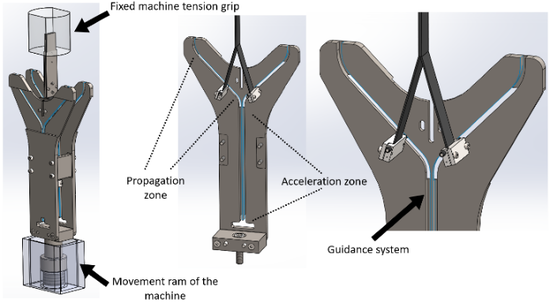1 Introduction
When advanced polymer-based composite materials are to be used in aeronautical structural components, a design development program is generally initiated during which the performance of the structure is assessed prior to its use. Typically, the process of design starts with the analysis of a large set of simple small specimens and, when sufficient knowledge is acquired at this level, it is changed over to a more complex structure but carrying out fewer tests. This methodology is quite mature and well stablished for static and even for fatigue loads. However, for intermediate and high dynamic loading conditions, the methods are still under development and often limited to academic research levels, without any type of standardization.
During their service life, aerospace structures can be subjected to a variety of dynamic loading cases. Crash/impact is one of the most concerning cases due to its possible disastrous consequences. Impacts on aerospace structures can be produced by the accidental or deliberate hit of an object into aircraft. Hailstones, bird strikes, runaway debris, tyre fragments or even other fragments from the aircraft structure that could be ejected in case of an accident (i.e. uncontained rotor engine failure) are examples that occur in the aerospace sector. Therefore, it is crucial to understand how the materials used in the aerospace sector behaves under dynamic loadings.
Composite materials may exhibit strain rate effects, therefore robust and industrial dedicated dynamic coupon and element level tests, analysis and modelling methods are then necessary to design and certify composite airframe structures. The analysis tools based on static formulations could be far away from the actual material and structural response, and hence a dedicated methodology is needed for dynamic loading states. This is what the European project entitled Development of a methodology to characterize the BEhaviour of composite structures under DYNamic loading, with the acronym BEDYN, will deal with.
1.1 Objetives
The aim of BEDYN is to address a methodology to properly characterize the dynamic behaviour up to rupture of thermoset polymer-based composite structures submitted to dynamic loading. Different associated objectives are accounted:
- Define a modelling approach suited to industrial needs for emergency situations applications (e.g. bird strike on a composite structure).
- Define associated dynamic tests (samples, experimental setup, etc.).
- Define a calibration and validation process.
- Demonstrate and evaluate the proposed methodology based on tests performed within the project.
1.2 Project details
BEDYN is a granted Clean Sky 2 Joint Undertaking (JU) project for call H2020-CS2-CFP10-2019-01, with Dassault Aviation as Topic Manager (TM). The project started on July 2020 and it will finish in June 2023 (36 months), with a total budget of 500 k€. The Grant Agreement is #886519 and the logo is included in Figure 1.
The project will be carried out by a consortium with different and complementary background and capabilities. The consortium is formed by: two universities, AMADE-UdG and UC3M; and a company, COMPOXI. The main role of each partner is associated with their main specialization, in detail:
- AMADE-UdG: project leader. Specialized on the development of modelling strategies for the simulation of structures manufactured with advanced composite materials; characterization of materials and structures under quasi-static loading; and development of data reduction methods of complex experimental tests.
- UC3M: analysis and testing for the characterization of advanced composite structures under dynamic loading conditions.
- COMPOXI: company specialized in manufacturing of composite coupons, elements, details and substructures for the aeronautical industry.
The topic of the project is collected to Airframe Integrated Technology Demonstrator (ITD), Part A WP A-1.4 oriented to “Virtual Modelling for Certification”, and specifically to WP A-1.4-2 on “Advanced criteria for rapid dynamic / crash modelling for safety”.
2 Work Packages
Basically, BEDYN project can be split into two differentiable sets of works: numerical and experimental. In accordance with the objectives of the project, the experimental part corresponds to defining the appropriate test methods to fully characterize thermoset-based composite materials under dynamic conditions, and to analyse different topics such as flexure response, notch effect and bearing response. The numerical part is focused on defining constitutive models and a simulation strategy accounting for dynamic effects, aligned with industrial purposes and thus a good balance of accuracy and computational analysis times.
These works are organized into 7 Work Packages (WP), the first 5 dedicated to technical tasks and the last 2 focused on management and communication activities. The relationship among the different WPs is schematically shown in Figure 3. The specifications and inputs from TM are key-points at each of the WPs.
The project starts and finishes in WP1, which contains the numerical activities to be performed (including the review, formulation and implementation of constitutive models and modelling strategy), but also, it includes the analysis of experimental results carried in the other WPs, as well as the validation of the whole methodology proposed for dynamic analysis.
All other technical WPs, are focused on experimental activities. On one side, these experimental activities deal with the complete characterization of a thermoset composite material under dynamic loading, including elastic properties ( , , , ), strength properties (fibre: , ; matrix: , ; shear: ) and fracture toughness (interlaminar: , , ; translaminar for a given laminate). The characterization also includes an adhesive bonded joint, thus in addition to the dynamic characterization of the associated fracture toughness, the strengths must be also described. On the other hand, other topics will be analysed experimentally: flexure response, notch effect and bearing. For all tests, specimens, test setups and well-suited data reduction methods must be defined based on literature reviews or novel test methods. Since in the literature there is no agreement on the effect of dynamic loads on some material properties (for both material characterizations: ply and delamination), and in some cases, it has never been studied, this topic is a challenge. Finally, simple flat-shaped structures will be manufactured for testing under out-of-plane gelatine-impact, as experimental data for the validation of the whole methodology. Accordingly, three different specimen types can be identified: “coupon”, for characterizing basic properties of the composite material (ply), interlaminar (delamination) and adhesive interfaces; “element”, they include what can be understood as small size demonstrator; “structure”, they are devoted for characterizing the behaviour at a subcomponent level under out-of-plane dynamic loads.
These experimental tasks will be carried out in four different WPs: WP2, definition of specimens; WP3, design of test setups and data reduction methods; WP4, manufacturing of specimens and new test rigs; and finally, WP5 the execution of the experimental test campaign.
In Table 1, the expected outcomes for each of the WPs are summarized.
| WP1. Dynamic modelling of material and structure
* Definition of a modelling methodology compatible with industrial needs for the prediction of the behaviour of composite structures subjected to dynamic loads. * Review of support analysis tools and methods for the definition of specimens in WP2, and test setups and data reduction methods in WP3, for dynamic loading characterization. * Analysis of experimental results from WP5. * Validation of the predictive modelling methodology. |
| WP2. Test specimens
* Define test coupons, elements and structures: samples, sizes and geometries, materials, stacking sequences, and associated material properties or structure responses. |
| WP3. Test setup design
* Define the test setup for each loading ratio and specimen category (coupons, elements and structures): tester, test rig and instrumentation. * Define the data reduction schemes for post processing the raw data extracted from each test. * Generate machining drawings for adapted mounts or test rigs. |
| WP4. Manufacturing: coupons, elements, structures and test rigs
* Manufacturing and cutting of panels to obtain the specimens. * Preparation of specimens for testing. * Mechanical manufacturing of required adapted mounts and test rigs. |
| WP5. Quasi-static and dynamic tests
* Perform quasi-static tests and apply associated data reduction methods. * Perform dynamic tests and apply associated data reduction methods. * Report of experimental results for each specimen category (coupon, element and structure). |
3 Methodology
For the development of the project, there are several Key Steps (KS) on which the BEDYN methodology will rely. These KS are described below according to the three main subjects that can be identified in the project: modelling, dynamic testing and manufacturing.
3.1 Modelling
3.1.1 KS1. Selection and development of the modelling strategy
The modelling strategy for the prediction of structures under dynamic loading will be based on using Continuum Damage Mechanics (CDM) implemented in Abaqus explicit finite element code. In particular, conventional shell elements together with cohesive elements or surface-based cohesive interfaces will be used (see the sketch in Figure 4). The use of shell elements is considered because of their kinematic simplicity and their useful capability to model a certain number of plies using a single shell element. Accordingly, the experimental characterization of the material will not be at laminate level, but rather at the ply level. This approach is compatible with industrial applications, allowing the simulation of any stacking sequence and composite structure. Its accuracy has been proven previously by the consortium simulating Low-Velocity Impact (LVI) and Compression After Impact (CAI) events, for laboratory coupons [1, 2] and aeronautical structures [3]. An important issue to be studied is the element distortion problem, which often appears when using a CDM approach in fast loading problems and it may suddenly stop the simulation.
3.1.2 KS2. Adapted intralaminar and interlaminar constitutive models
Although the selection of the constitutive models is implicitly done in the modelling strategy (KS1), they should be considered as a separate Key Step, given their complexity and the difficulties involved. Initially, and always after having made a complete bibliographic review of this topic, the constitutive models of the consortium that have been tested successfully for other loading cases (mostly static loading, but also in LVI tests and recently, they have been adapted for fatigue simulations), will be adapted for the simulation with dynamic loading. The reference models will be [4, 5] for intralaminar damage and [6] for interlaminar prediction. For example, for the interlaminar damage modelling the dynamic approaches described by May et al. [7, 8] will be considered. To achieve this adaptation, it will be necessary to know before which material properties are strain rate dependent. This may not have an answer, because there may not be an experimental test that gives a reliable answer. Even so, a generalist formulation can be performed so that the model is able to be defined strain rate dependent for some desired material properties.
3.2 Dynamic testing
3.2.1 KS3. Dynamic material characterization
In the Building Block Approach method, different structure levels must be tested to increase test complexity while maintaining confidence levels on the experimental and numerical results. In BEDYN project, it is proposed to perform a basic material characterization in both, intralaminar and interlaminar levels (the last includes the co-bonded interface and the delamination interface). The tests considered are summarized in Table 2 and Table 3. The use of the Split Hopkinson Pressure Bar (SHPB) bar will be required for both compressive and tensile configurations. Different coupon geometries will be used to obtain the different properties required for the model in the dynamic regime. However, there are still particular properties at which there is no available tests, such as for the dynamic interlaminar fracture toughness characterization. AMADE-UdG and UC3M were working in the development of this experimental characterization and it will be used for the present project (limited to pure mode I crack propagation; see sketches in Figure 5). The selection of the specimen and test setups will be mainly done by Finite Element simulations. An important result to be satisfied is the load equilibrium during the dynamic tests to properly obtain the corresponding characterization without any inertial effect.
For SHPB test, the use of high speed camera will allow to apply Digital Image Correlation (DIC) method to obtain displacement and strain rate fields. To obtain the stress state and static equilibrium, the SHPB theory will be used.
A unidirectional tape of epoxy/carbon fibre prepreg material and an epoxy adhesive film will be used (see Table 4). Two different strain rates, plus static tests will be performed. It is worth mentioning that the static tests will be based, whenever possible, on standardized test methods. The specimen sample considered for each test configuration will be of 3+1 specimens (three for testing plus one for reserve). All specimens will be stored at laboratory conditions, 23ºC and 50%RH.
| Type | Tester | Reference | Results |
| Longitudinal compression | SHPB-C | Ploeckl et al. (2017) [9] BEDYN research |
, , |
| Transverse and off-axis tensile | SHPB-T | Kuhn et al. (2015) [10]
Quino et al. (2020) [11] |
, ,
Failure envelope: -
|
| Transverse and off-axis compression | SHPB-C | Koerber et al. (2010) [12]
Ploeckl et al. (2017) [9] BEDYN research |
,
Failure envelope: - |
| Type | Tester | Reference | Results |
| Double Cantilever Beam - Pure mode I (DCB) | Instron servo hydraulic dynamic | AMADE-UdG procedure
(see Figure 5) |
: onset and propagation, interlaminar and adhesive bonded joint |
| End Notched Flexure - Pure mode II (ENF) | SHPB-C | Lißner et al. (2020) [13]
Shamchi et al. (2022) [14] BEDYN research |
: onset and propagation, interlaminar and adhesive bonded joint |
| Single Leg Bending Test - Mixed-mode 41% (SLB) | SHPB-C | Lißner et al. (2020) [13]
BEDYN research |
: onset and propagation, interlaminar and adhesive bonded joint |
| Butt Joint (BJ) | SHPB-T | Neumayer et al. (2016) [15]
BEDYN research |
: pure mode I strength adhesive bonded joint |
| Single Lap Shear - SLS | SHPB-C | BEDYN research | : pure mode II strength adhesive bonded joint |
| Item | Definition |
| Composite Material | Hexply® M21EV/34%/UD200/IMA/150ATL |
| Adhesive | FM® 300M |
3.2.2 KS4. Dynamic structure characterization
In order to analyse the effect of different properties as the notch effect (size effect), flexural behaviour and the bearing effect, element (i.e. small size demonstrator) and structure (i.e. subcomponent level) specimens will be considered in the test matrix. The element and structure tests considered are collected in Table 5 and Table 6. The use of the SHPB bar will be required for both compressive and tensile configurations.
The scope of these tests are: two stacking sequences, two notch sizes and two fastener diameters for bearing tests (see Table 7). It has to be noted that if specimen sizes are not adequate, it may be difficult to detect any clear effect. The specimen sample considered for each test configuration will be of 3+1 specimens (three for testing plus one for reserve). Also, two different high strain rates plus the quasi-static tests will be performed. To avoid any possible size effect, the specimens used for quasi-static testing will be with the same features as the ones used dynamically.
| Type | Tester | Reference | Results |
| Three point bending
(3PB) |
SHPB-C | Zhang et al. (2012) [16]
BEDYN research |
Flexural strength |
| Filled Hole Tension (FHT) | SHPB-T | BEDYN research | Notch effect:
Remote strength |
| Filled Hole Compression (FHC) | SHPB-C | BEDYN research | Notch effect:
Remote strength |
| Compact Tension (CT) | SHPB-T | Hoffman et al. (2018) [17]
BEDYN research |
Notch effect:
translaminar fracture toughness |
| Composite-aluminium bolted joint (Bearing) | SHPB-T | BEDYN research | Bearing:
Remote strength |
| Type | Tester | Reference | Results |
| Out-of-plane gelatine impact on flat-shaped laminates (500 mm x 500 mm) | Gas gun | BEDYN research | DIC - high speed cameras
Non-destructive Inspections |
Regarding the testing at the subcomponent level, it will be used the pneumatic launcher from UC3M lab in which a bird substitute projectile will impact against a flat panel. The results of these tests will be used for the validation and verification of the BEDYN methodology by the TM. A total of 4 specimens will be manufactured, 2 for each stacking sequence to be tested at 2 different gelatine impact velocities, with 1 repetition for each configuration. All impact tests will be recorded with at least 3 high speed video-cameras, allowing also to obtain the strain rate and the strain field of the structure. Testing at a component level and beyond will not be considered in this proposal.
| Item | Definition |
| Fasteners: FHT, FHC and Bearing | Titanium |
| Aluminium plate: Bearing | 2024-T3 |
| Lay-ups for Element and Structure type specimens | Layup #1: [-45/02/45/90/45/02/-45/0]S
Layup #2: [45/0/-45/90/-45/0/45/90/-45/0/45/90]S |
| FHT and Bearing
(FHC, just Size #1 is tested) |
Size #1: hole 4 mm; width 24 mm (T = 2 mN)
Size #2: hole 8 mm; width 48 mm (T = 16 mN) |
The total number of tests to be performed including material characterization, elements and structures is of 476, 184 quasi-static plus 292 dynamic.
3.3 Manufacturing
3.3.1 KS5. Quality of the specimens and milling operations
Since the material properties and structure responses are essential data for the development of the BEDYN methodology, to manufacture and to milling specimens with high quality is a Key Step in the project. However, due to the high specialization of COMPOXI in the manufacture of composite structures, as it is demonstrated in previous projects developed by the company, the manufacturing quality will be guaranteed for any specimen type.
3.3.2 KS6. Quality of the adapted mounts and test rigs
AMADE-UdG and UC3M have proven experience in the experimental characterization of materials in both, quasi-static and dynamic regimes. Moreover, both research groups have the experience of developing new test setups (including the manufacturing of different adapted mounts and test rigs) to perform innovative experimental testing conditions. The successful previous experience of the partners will assure the expected quality for this activity.
Therefore BEDYN will represent major advances or even pioneering works in the characterization of coupons based on the laminate level. Also same degree of advances are expected for the characterization in the elements level in which only scarce information can be found about the behaviour of such complex structures under high strain rate loading. The few works published in the scientific literature does not reach the strain rate that are present in an impact event. BEDYN will focused in this high strain rate range using the SHPB apparatus for reaching that level of loading rates.
4 Conclusions
The BEDYN project will address a methodology to properly characterize the dynamic behaviour up to rupture of thermoset polymer-based composite structures submitted to dynamic loading. The methodology includes the definition of test methods for the complete characterization of composite materials under dynamic loading as well as the definition of a finite element modelling strategy for the prediction of composite structures loaded dynamically. The project is challenging since dynamic test methods are scarce in the literature, without no standardization and often without consensus in the associated works for a given property. Therefore, the project implies the selection of specimens, test setups (tester and instrumentation) and well-suited data reduction methods. The methodology is completed with the selection of a modelling strategy for industrial purposes which will be fed by the dynamic material data cards defined.
The BEDYN project will contribute towards the consolidation of the use of numerical simulation in the design phase of polymer-based composite structures under dynamic loading. The BEDYN project will address innovative technologies, allowing better product development thanks to an increased knowledge of the behaviour of composite materials under dynamic loading. Maturing and validation of technologies is a key aspect of integrating research in the development process of industrial activities and next generation aircrafts.
Acknowledgements
This project has received funding from the Clean Sky 2 Joint Undertaking (JU) under grant agreement No. 886519. The JU receives support from the European Union’s Horizon 2020 research and innovation programme and the Clean Sky 2 JU members other than the Union.
References
[1] A. Soto, E. V. González, P. Maimí, F. M. De La Escalera, J. S. De Aja, and E. Alvarez, ‘Low velocity impact and compression after impact simulation of thin ply laminates’, Composites Part A: Applied Science and Manufacturing, vol. 109, pp. 413–427, 2018.
[2] E. V. González, P. Maimí, E. Martín-Santos, A. Soto, P. Cruz, F. M. De La Escalera, J. S. De Aja, ‘Simulating drop-weight impact and compression after impact tests on composite laminates using conventional shell finite elements’, International Journal of Solids and Structures, vol. 144, pp. 230–247, 2018.
[3] A. Soto, E. V. González, P. Maimí, J. A. Mayugo, P. R. Pasquali, and P. P. Camanho, ‘A methodology to simulate low velocity impact and compression after impact in large composite stiffened panels’, Composite Structures, vol. 204, pp. 223–238, 2018.
[4] P. Maimí, P. P. Camanho, J. Mayugo, and C. Dávila, ‘A continuum damage model for composite laminates: Part I–Constitutive model’, Mechanics of materials, vol. 39, no. 10, Art. no. 10, 2007.
[5] P. Maimí, P. P. Camanho, J. Mayugo, and C. Dávila, ‘A continuum damage model for composite laminates: Part II–Computational implementation and validation’, Mechanics of materials, vol. 39, no. 10, Art. no. 10, 2007.
[6] A. Turon, E. V. González, C. Sarrado, G. Guillamet, and P. Maimí, ‘Accurate simulation of delamination under mixed-mode loading using a cohesive model with a mode-dependent penalty stiffness’, Composite Structures, vol. 184, pp. 506–511, 2018.
[7] M. May, T. R. Lässig, and S. J. Hiermaier, ‘An Investigation on the Influence of Loading Rate on the Fracture Toughness of UHMW-PE Composites’, 2016.
[8] M. May, ‘Numerical evaluation of cohesive zone models for modeling impact induced delamination in composite materials’, Composite Structures, vol. 133, pp. 16–21, 2015.
[9] M. Ploeckl, P. Kuhn, J. Grosser, M. Wolfahrt, and H. Koerber, ‘A dynamic test methodology for analyzing the strain-rate effect on the longitudinal compressive behavior of fiber-reinforced composites’, Composite Structures, vol. 180, pp. 429–438, 2017.
[10] P. Kuhn, M. Ploeckl, and H. Koerber, ‘Experimental investigation of the failure envelope of unidirectional carbon-epoxy composite under high strain rate transverse and off-axis tensile loading’, in EPJ Web of Conferences, 2015, vol. 94, p. 01040.
[11] G. Quino, V. L. Tagarielli, and N. Petrinic, ‘Effects of water absorption on the mechanical properties of GFRPs’, Composites Science and Technology, vol. 199, p. 108316, Oct. 2020, doi: 10.1016/j.compscitech.2020.108316.
[12] H. Koerber, J. Xavier, and P. P. Camanho, ‘High strain rate characterisation of unidirectional carbon-epoxy IM7-8552 in transverse compression and in-plane shear using digital image correlation’, Mechanics of Materials, vol. 42, no. 11, Art. no. 11, 2010.
[13] M. Lißner, E. Alabort, B. Erice, H. Cui, B. R. Blackman, and N. Petrinic, ‘On the dynamic response of adhesively bonded structures’, International Journal of Impact Engineering, vol. 138, p. 103479, 2020.
[14] S. P. Shamchi, M. F. S. F. de Moura, Z. Zhao, X. Yi, and P. M. G. P. Moreira, ‘Dynamic mode II interlaminar fracture toughness of electrically modified carbon/epoxy composites’, International Journal of Impact Engineering, vol. 159, p. 104030, 2022, doi: https://doi.org/10.1016/j.ijimpeng.2021.104030.
[15] J. Neumayer, P. Kuhn, H. Koerber, and R. Hinterhölzl, ‘Experimental determination of the tensile and shear behaviour of adhesives under impact loading’, The Journal of Adhesion, vol. 92, no. 7–9, Art. no. 7–9, 2016.
[16] Y. Zhang, B. Sun, and B. Gu, ‘Experimental characterization of transverse impact behaviors of four-step 3-D rectangular braided composites’, Journal of composite materials, vol. 46, no. 24, Art. no. 24, 2012.
[17] J. Hoffmann, H. Cui, and N. Petrinic, ‘Determination of the strain-energy release rate of a composite laminate under high-rate tensile deformation in fibre direction’, Composites Science and Technology, vol. 164, pp. 110–119, 2018.
Document information
Published on 30/10/22
Accepted on 30/10/22
Submitted on 30/10/22
Volume 06 - AEMAC en PROYECTOS EUROPEOS (2022), Issue Num. 2 - Monográfico Proyectos Europeos (2), 2022
DOI: 10.23967/r.matcomp.2022.11.05
Licence: Other
Share this document
Keywords
claim authorship
Are you one of the authors of this document?



